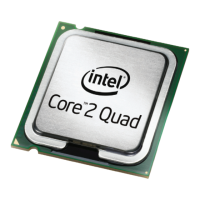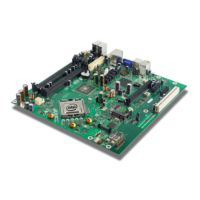Processor Thermal/Mechanical Information
Thermal and Mechanical Design Guidelines 15
2.1.2 Heatsink Attach
2.1.2.1 General Guidelines
There are no features on the LGA775 socket to directly attach a heatsink: a
mechanism must be designed to attach the heatsink directly to the motherboard. In
addition to holding the heatsink in place on top of the IHS, this mechanism plays a
significant role in the robustness of the system in which it is implemented, in
particular:
• Ensuring thermal performance of the thermal interface material (TIM) applied
between the IHS and the heatsink. TIMs based on phase change materials are
very sensitive to applied pressure: the higher the pressure, the better the initial
performance. TIMs, such as thermal greases, are not as sensitive to applied
pressure. Designs should consider a possible decrease in applied pressure over
time due to potential structural relaxation in retention components.
• Ensuring system electrical, thermal, and structural integrity under shock and
vibration events. The mechanical requirements of the heatsink attach mechanism
depend on the mass of the heatsink and the level of shock and vibration that the
system must support. The overall structural design of the motherboard and the
system have to be considered when designing the heatsink attach mechanism.
Their design should provide a means for protecting LGA775 socket solder joints.
The Intel ALCT reference design attach mechanism described in Section.
5.6
Note: Package pull-out during mechanical shock and vibration is constrained by the LGA775
socket load plate (refer to the LGA775 Socket Mechanical Design Guide for further
information).
2.1.2.2 The Pump Assembly Clip Load Requirement
The attach mechanism for the pump assembly developed to support the processor
should create a static preload on the package between 18 lbf and 70 lbf throughout
the life of the product for designs compliant with the Intel reference design
assumptions:
• 72 mm x 72 mm mounting hole span (refer to
Figure 66)
The minimum load is required to protect against fatigue failure of socket solder joint in
temperature cycling.
It is important to take into account potential load degradation from creep over time
when designing the pump assembly clip to the required minimum load. This means
the initial preload at beginning of life of the product may be significantly higher than
the minimum preload that must be met throughout the life of the product. For
additional guidelines on mechanical design, in particular on designs departing from the
reference design assumptions, refer to
Appendix A.
For clip load metrology guidelines, refer to
Appendix B.

